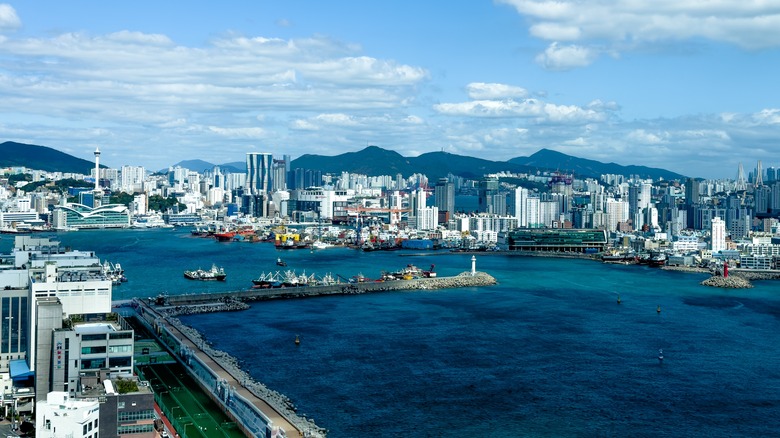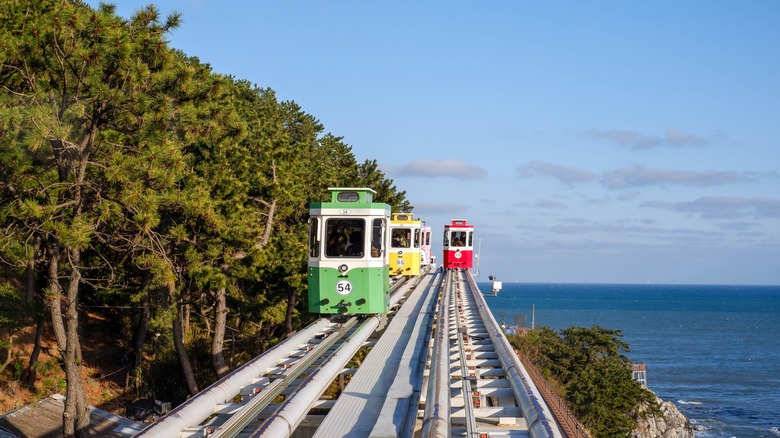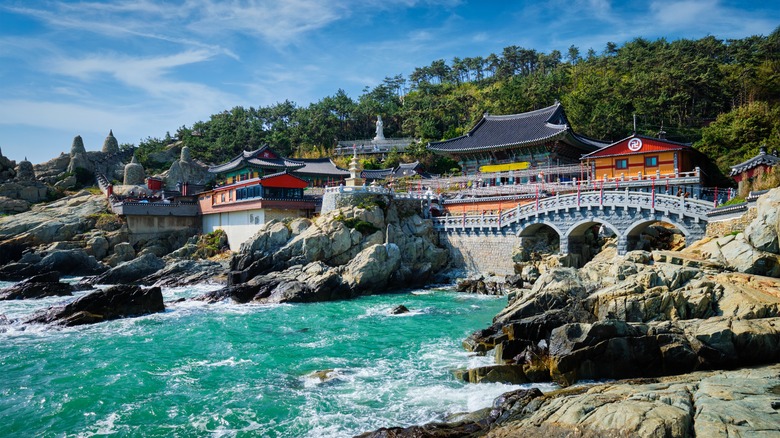South Korea's Second-Largest City Is A Breathtaking Beach Paradise With Markets, Temples And Mountains
Home to legendary K-pop groups like BTS, addictive TV shows like "Squid Games," and the aromatic and spicy kimchi, South Korea has become a huge exporter of culture. It has also become an up-and-coming travel destination as many venture to the dazzling capital of Seoul or the mesmerizing Jeju Island, a UNESCO World Heritage Site with imposing volcanoes and delicious seafood. However, if you want to be somewhere more laid-back that is close to cultural sites like markets and temples as well as the ocean and the mountains, you might consider South Korea's second-largest city, Busan.
Busan, a large port city on the southeastern coast of the Korean Peninsula, is about 198 miles south of the capital. There are no direct flights to Busan from the U.S., so you'd need to transfer from Seoul. After exploring Seoul's Hongdae neighborhood, known for its indie music scene and thriving nightlife, hop on a KTX bullet train to Busan, which will take just over two hours. If you plan to travel by KTX throughout South Korea, you can consider getting a Korail Pass. Alternatively, you can choose the Express Bus option if you are on a budget. The travel time is 4.5 hours, and it is about less than half the price of the KTX bullet train.
Best beaches in Busan
Haeundae Beach is the most beloved vacation destination in the Korean Peninsula, attracting local and foreign tourists from far and wide. The 1-mile white sand beach in Busan with calm, aquamarine water is a fantastic beach for swimming and surfing while enjoying the spectacular views of skyscrapers.
Our favorite building is the Haeundae LCT The Sharp. At 1,350 feet, it's the second tallest building in South Korea. Head to the X the Sky observatory deck on the 100th floor for an incredible view of the turquoise ocean and Busan's diverse skyline. If you want to admire the view on a budget, take the Haeundae Blueline Park Beach Train to Cheongsapo Daritdol Skywalk, a free observatory. The Sky Capsule, a monorail, is also super Instagrammable and a fun way to explore Busan's coast.
When you're hungry after all the exploring, head to the Haeundae Traditional Market for some traditional South Korean food. Have a meal at one of the seafood restaurants or try kalguksu (Korean knife-cut noodle soup) and dumplings. Don't forget to get a honeycomb ice cream as dessert. Gukje Market is another must-visit, as it's one of the largest in South Korea. It started right after the Korean War when locals tried to make a living by selling U.S. Army goods or other smuggled products. It has become a sprawling complex with vendors connected by suspension bridges specializing in quirky items and some of Busan's best food stalls. You can easily spend an afternoon meandering around, shopping for knickknacks, and trying some of the market's classic street foods, like bibim dangmyeon (spicy glass noodles) and tteokbokki (spicy rice cakes).
Explore culture through temples and mountains
Within a short walk from Gukje Market is the Daegaksa Temple, built during the Japanese colonial era. It has a Japanese stone pagoda and a courtyard filled with lanterns. It's the perfect little break as you explore Gwangbok-dong, a hip district known for shopping and eating. It's also close to Yongdusan Park, a mountainous area where the Busan Diamond Tower stands. The 394-foot tower has an observatory where you can soak up a 360-degree view of Busan.
The most iconic temple in Busan is the Haedong Yonggungsa Temple. Built on the edge of a cliff facing the coast, the temple's name means "Dragon Palace by the Sea" in Korean. Established during the Silla Dynasty in 678, it is now one of the five major centers of South Korea's Jogye Order of Buddhism. It rests on Geumjeongsan Mountain, and the view alone is jaw-droppingly beautiful. There is a towering statue of a Buddhist goddess whose benevolent gaze overlooks the complex. The temple is a little far from the city, but the grand and colorful structure and its tranquil and serene vibe are well worth the trek.
After your visit, look for signs that point to Geumjeong Fortress, which is the starting point of a hike. The three- to four-hour gentle hike will take you to a mountain trail following a creek and through a lush forest. Once you reach the peak of Mount Geumjeongsan, you will be rewarded with magnificent panoramic views. If you're looking for more Busan adventures, head to the colorful mountainside Gamcheon Cultural Village known as "South Korea's Santorini," a cultural village filled with murals and street art.


